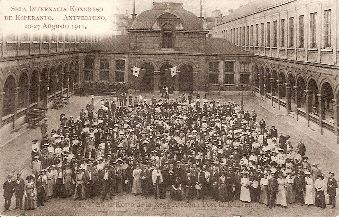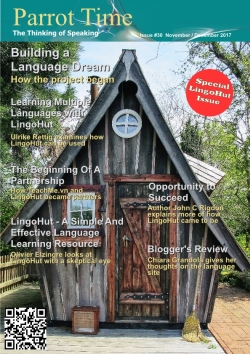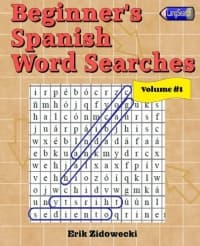Constructed Languages
Making It All Up

|
There are over six thousand natural languages in the world, with only a relatively small number of those being used and learned by the majority of people in the world. The rest are used by smaller groups of people in villages and tribes. Despite this huge number of languages, and in some cases because of it, some people have created their own languages, forming their own syntax, grammar and vocabulary. These are called "constructed languages" or simply "conlangs". These are not to be confused with pidgin languages, which arise when two or more languages collide with each other, causing the people involved to merge them into a new language as a necessity to communication. Nor are these creoles, which are what happens when a pidgin becomes spoken as a primary language instead of a helping or auxiliary one. A conlang is an entirely new entity. It is likely to borrow some aspects of other languages, for the creators will have previous language experience to use. They are developed for a number of different reasons, the first one being, rather ironically, to ease the problem with there being so many languages. History of Auxiliary Languages This particular kind of conlang is known as an international auxiliary language, also referred to as an IAL or auxlang. The most well known is Esperanto. These are created as a means of communication between the people of different countries that share no other common languages. These are not meant to replace the native language, but simply to offer a secondary shared language. You can see how this could be useful when two world leaders meet and want to discuss issues without using an interpreter. If one person speaks German and the other Swahili, an auxiliary language that both know could be used instead. Such IALs could certainly be useful in simplifying the interpretation and translation nightmare that exists in organizations like the United Nations. Of course, it means that everyone needs to know the auxiliary language. So why create another language when there are so many natural ones that could be used instead? Essentially, learning languages is not easy for most people, and while an IAL would still take time and effort to learn, they are designed to be much easier to learn. One of the first IALs was Volapük, created around 1879 by Johann Martin Schleyer. It got a lot of attention and was used in a few conventions, but was eventually abandoned and a newer and easier language was wanted. Interlingua is an IAL based upon Latin, developed in the first half of the 20th century. It is a naturalistic IAL, meaning its basic components (vocabulary, grammar, etc.) are based upon natural languages. The design was to combine the most common elements from a large number of languages to make it easier to learn for everyone. This is different from Volapük which adopted most of its vocabulary from English and most of its grammar from European languages. Esperanto  7th Esperanto congress, Antwerp, Belgium, August 1911 Esperanto was created by L. L. Zamenhof in the 1870s and was first published in 1887. It is also a naturalistic IAL, and gained a large following, especially among language learners. A major strength with Esperanto is that while it has a vocabulary that can be at least partially recognized rather easily by speakers of many languages, given that is where the words were derived, the grammar and verb structures are also greatly simplified. There are no irregular verbs in Esperanto, so a learner does not need to memorize all the different exceptions. That alone is often a major obstacle to learning natural languages. But while being learned by hundreds of thousands of people in numerous countries throughout the world, it never really became adopted as an international language, at least it the way it was originally intended. While people use it to communicate, the same as with a natural language, it is not used in the geopolitical arena and no world leaders or major world organizations are using it as their primary means of communications. Many people learn languages as part of understanding another culture or as something to use in their daily lives. To them, a conlang helps them with neither of those things. Why have we never fully adopted an IAL, such as Esperanto or Interlingua? I think the main reason is that the average person is resistant to learning a second language. In some countries, language education is heavily promoted, and in some specific instances, becoming bilingual is quite normal. But when a person learns a language, they do so because it is part of their daily life or has a practical usage. Being taught a language that has no daily practicality seems pointless to most. In order for an IAL to really be useful, everyone would have to learn the same one. Even if that language is easier than most to learn, a person that does not want to learn another language might resent being told they have to, while a person that does learn other languages might resent being told they have to learn that specific one. English and French have become more of the internationally used languages, and they are both natural languages. So why do not people rebel against them (more than they already do, at least)? Perhaps because learning one of those gives the learner access to another culture instantly, while there is no culture based around an IAL (although Esperanto has made great strides in creating its own community and culture). Many language learners have fully adopted Esperanto and love to use it with others. They will extol its numerous virtues and encourage you to learn it, perhaps even more than is done for a natural language. I feel in that capacity, it loses its auxiliary status and becomes a regular conlang. Logical Languages  Page from the Voynich Script, which may contain a constructed language. No one has been able to translate it. A more recent creation is Lojban, created in 1987 by "The Logical Language Group" (LLG). It was based upon Loglan, which was invented by James Cooke Brown in 1955 and developed by The Loglan Institute. Unlike Esperanto and Volapük, Loglan was not solely created as an IAL. Its original purpose was to test the Whorf-Sapir hypothesis of the influence of language on the way a person thinks. That is, they wanted to make a language so unique that it would force people to think in an entirely new way. It was the first "logical language". Compared to the enthusiasm for Esperanto, I have met only a few people that even know or care about Loglan or Lojban. I think they fail to capture the romance of languages the way the IALs do. Potential Conlangs There are a few historical artifacts that have unknown scripts and languages which have not yet been successfully translated. One of these is the Voynich Manuscript, a series of pages with many drawings and diagrams along with a script which seems to have many characteristics of a natural language. Since it unlike any other recognized language, the general consensus is that it is either a complete hoax or a created language. |
| Constructed Languages - Making It All Up | ||||||
| Writer: | Erik Zidowecki | |||||
| Images: | ||||||
| ||||||
| Sources: | ||||||
| ||||||
All images are Copyright - CC BY-SA (Creative Commons Share Alike) by their respective owners, except for Petey, which is Public Domain (PD) or unless otherwise noted.
comments powered by Disqus
















